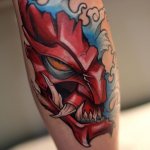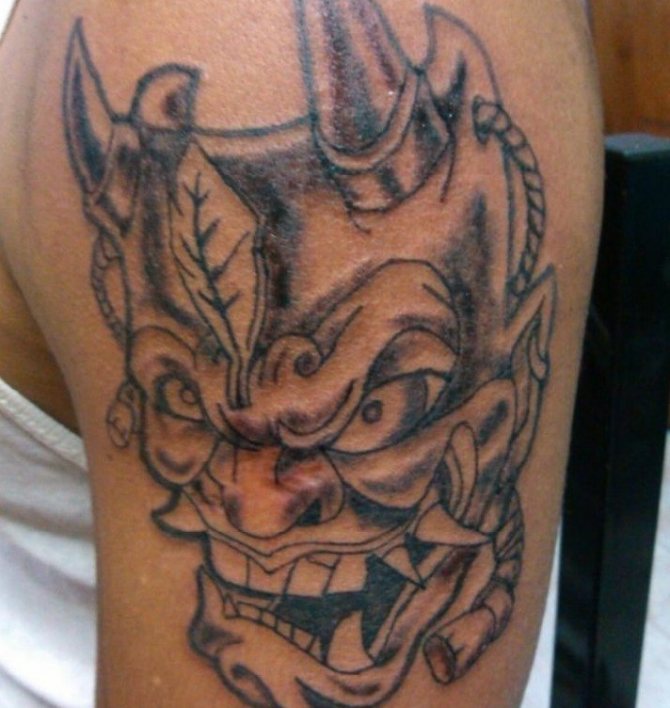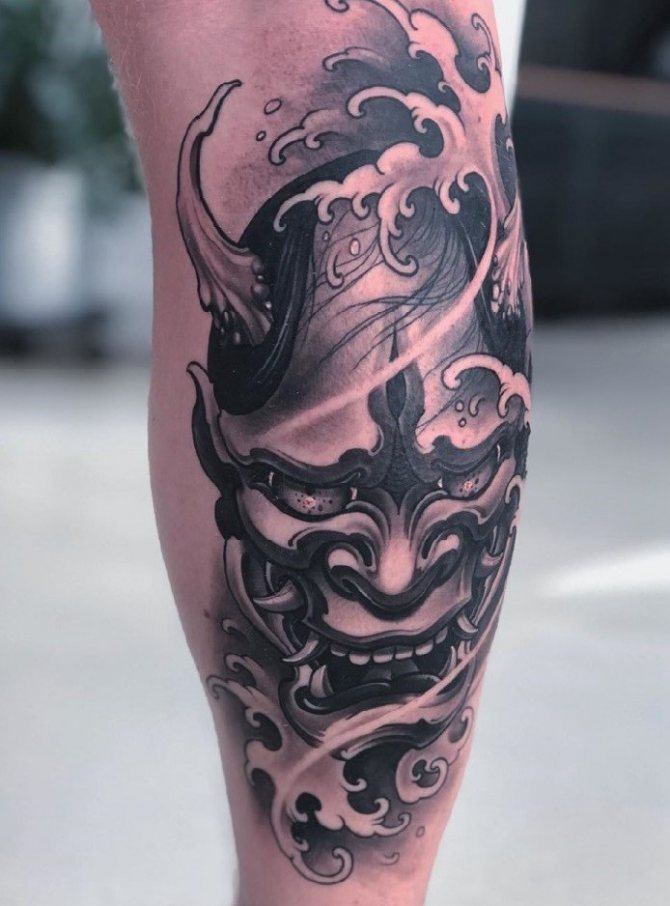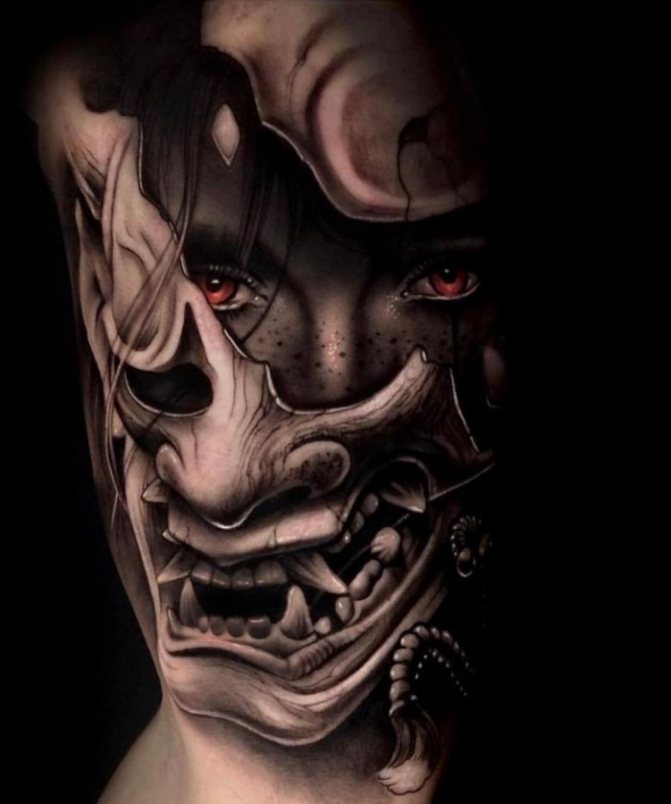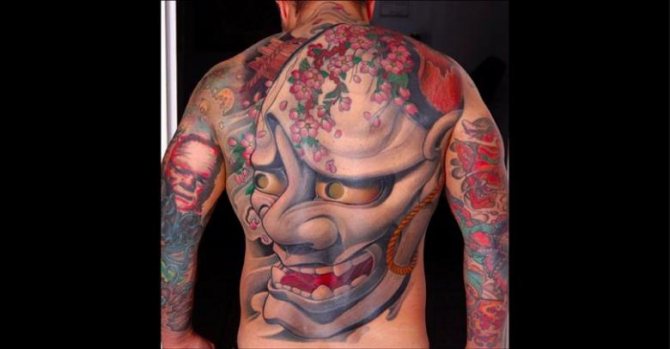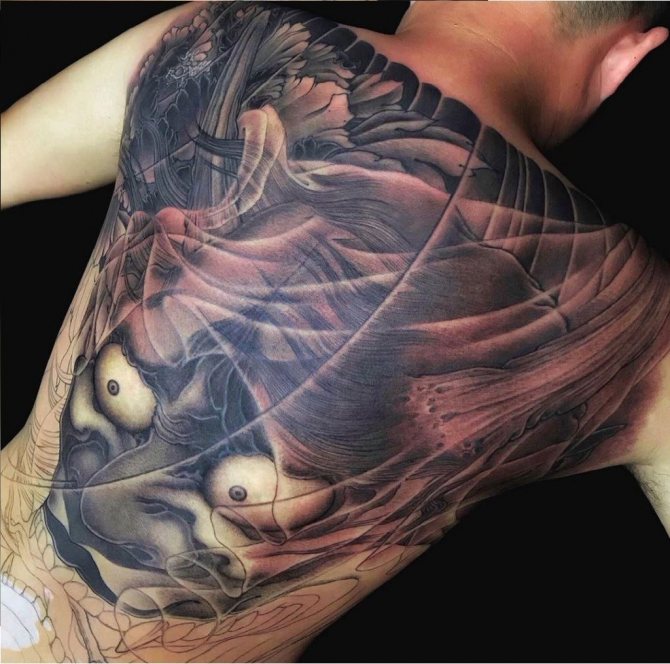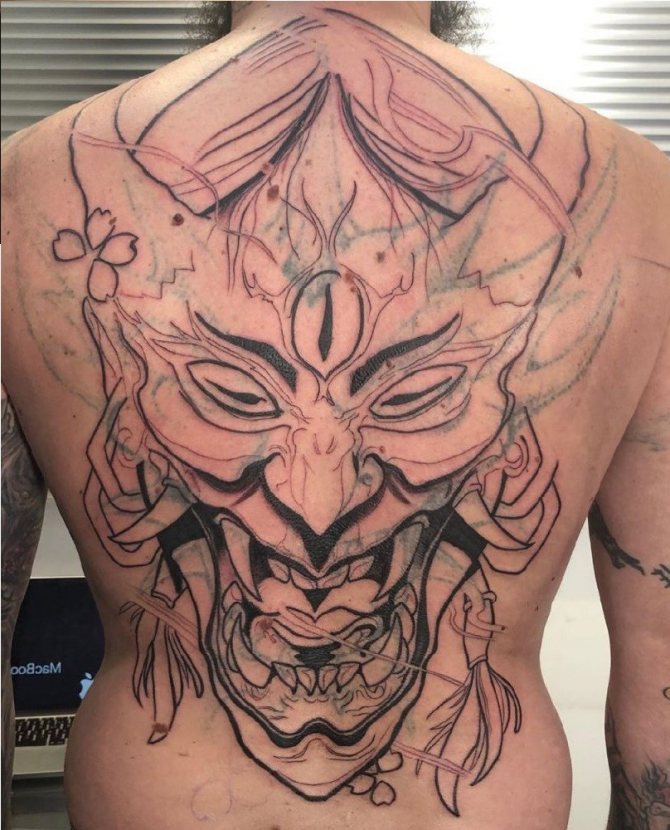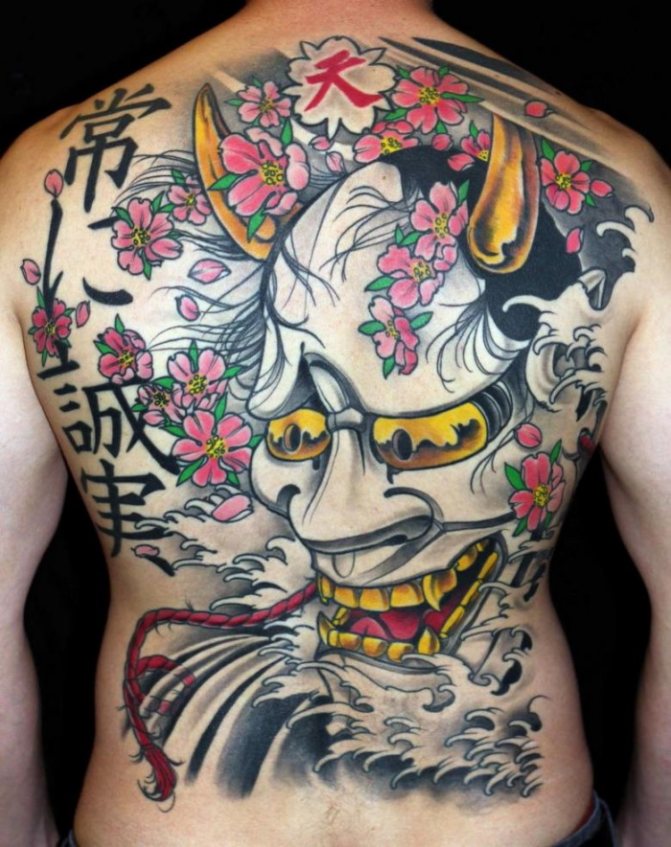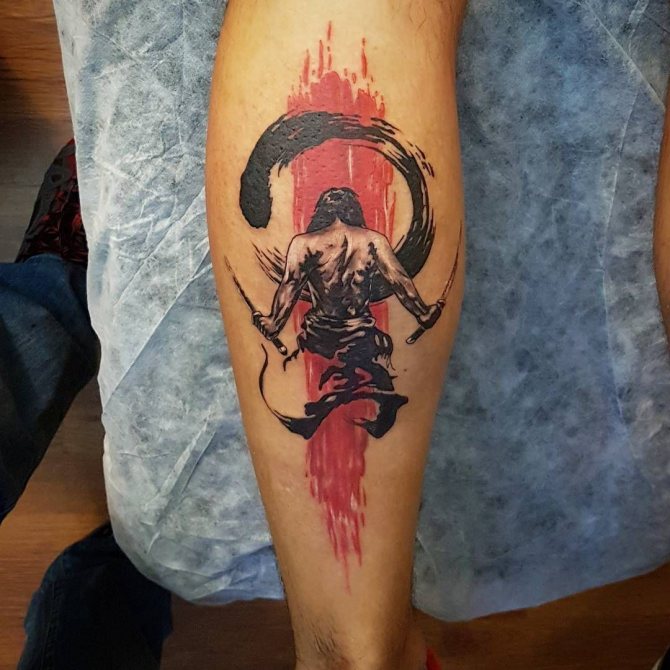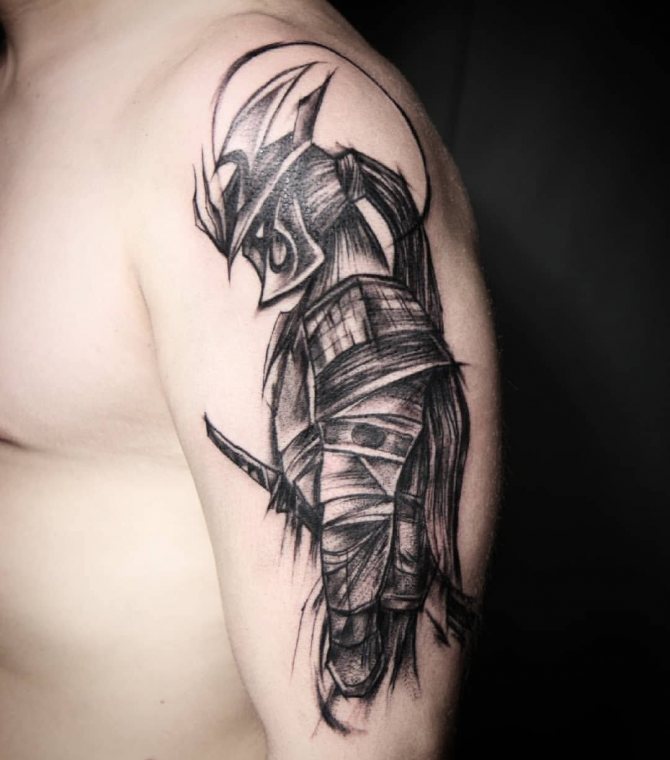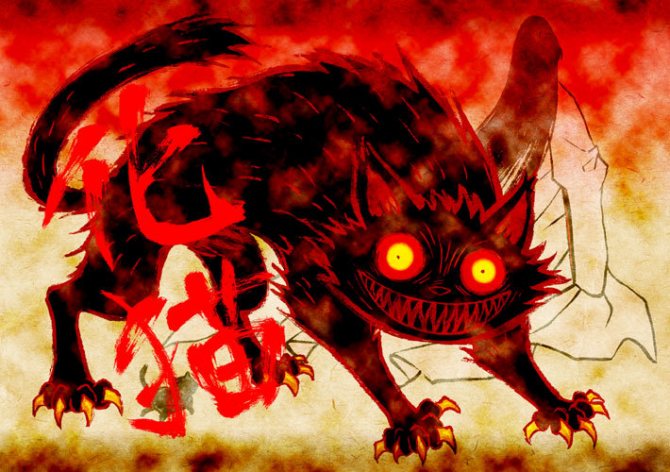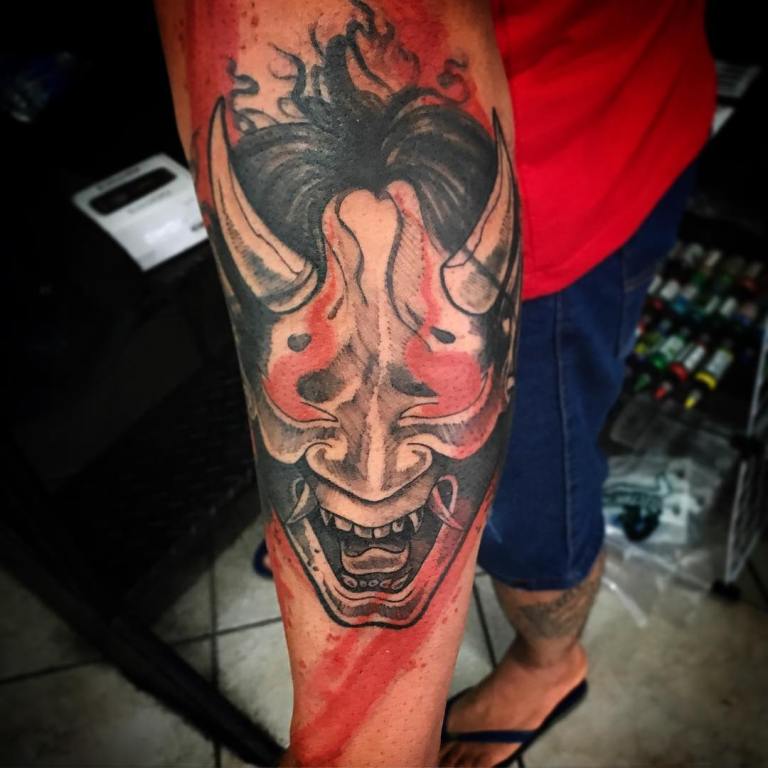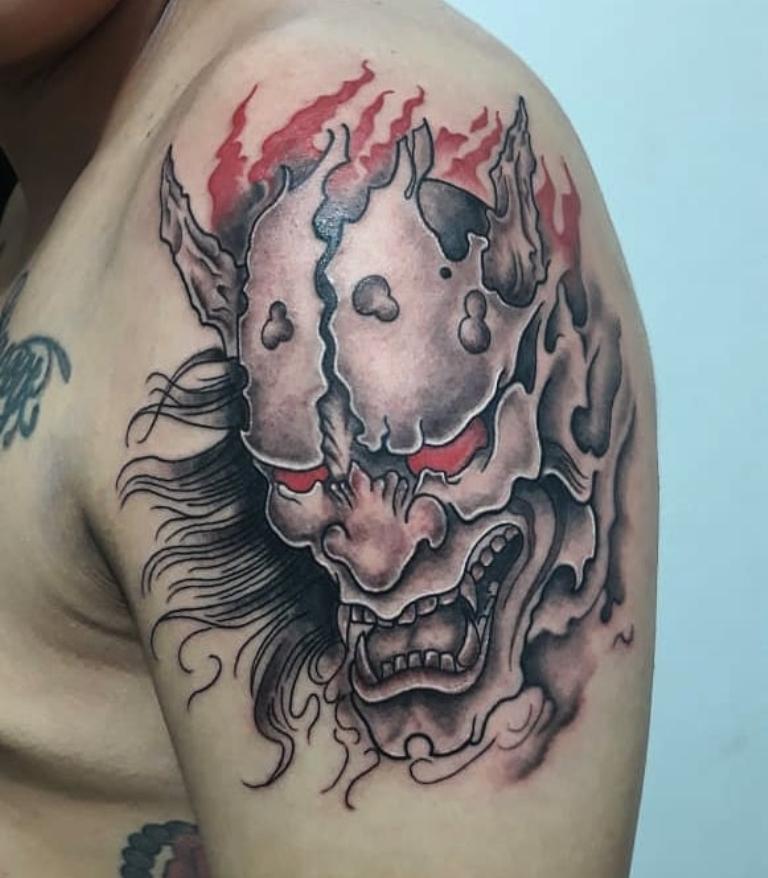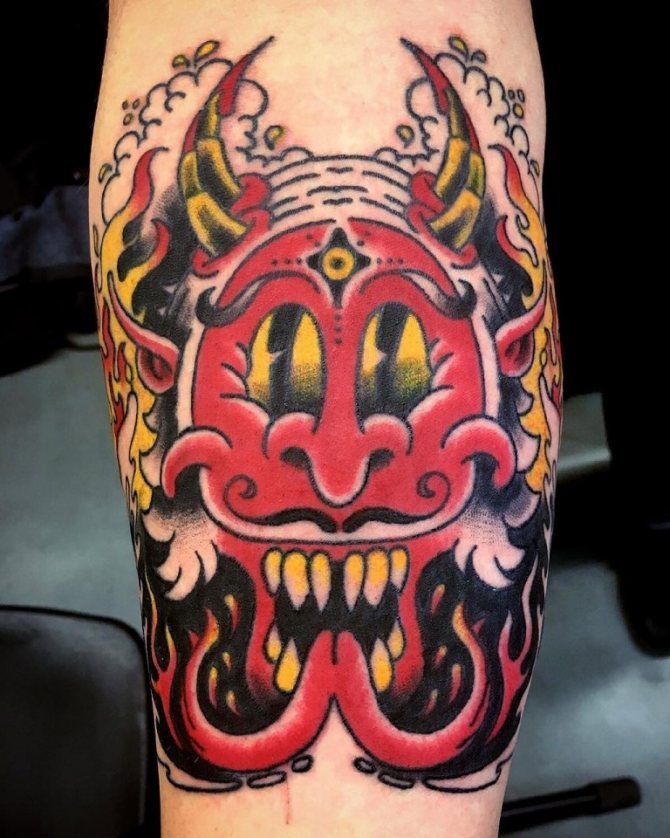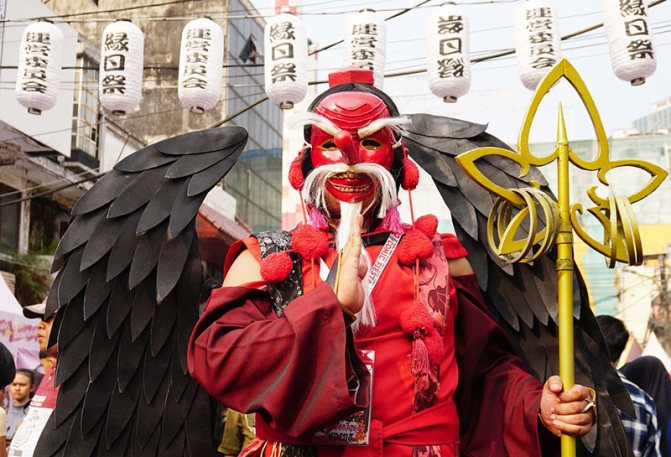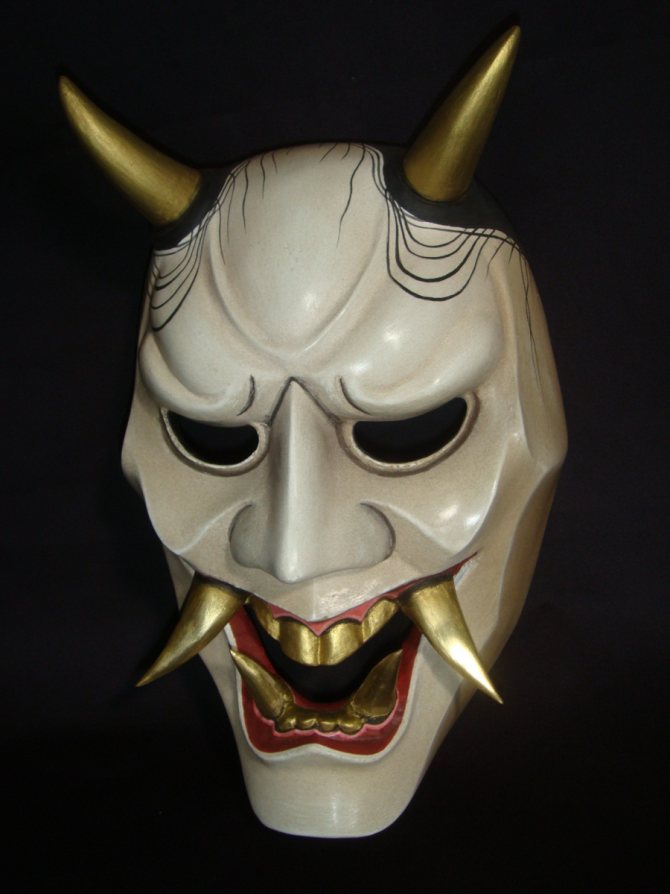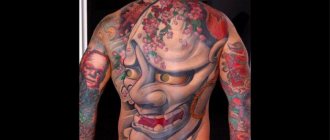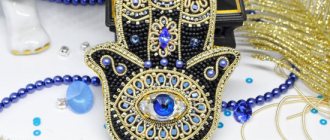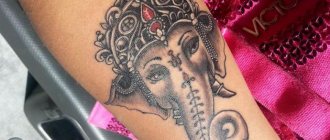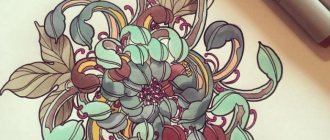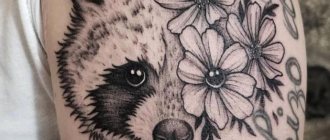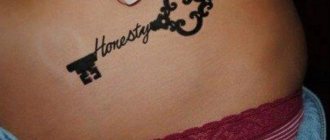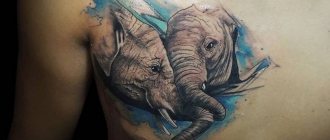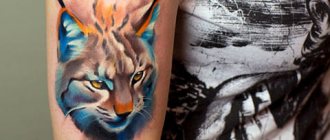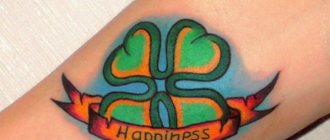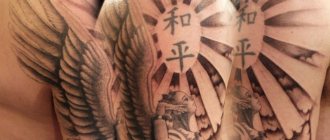Tattoo Hania - one of the most popular motifs among fans of Asian culture. This phenomenon can be explained by the fact that the Japanese mask displays the ability to resist evil forces and inner energy. In this article we will consider interesting sketches of frightening creatures, as well as consider the detailed meaning of the demon tattoo for guys and girls.
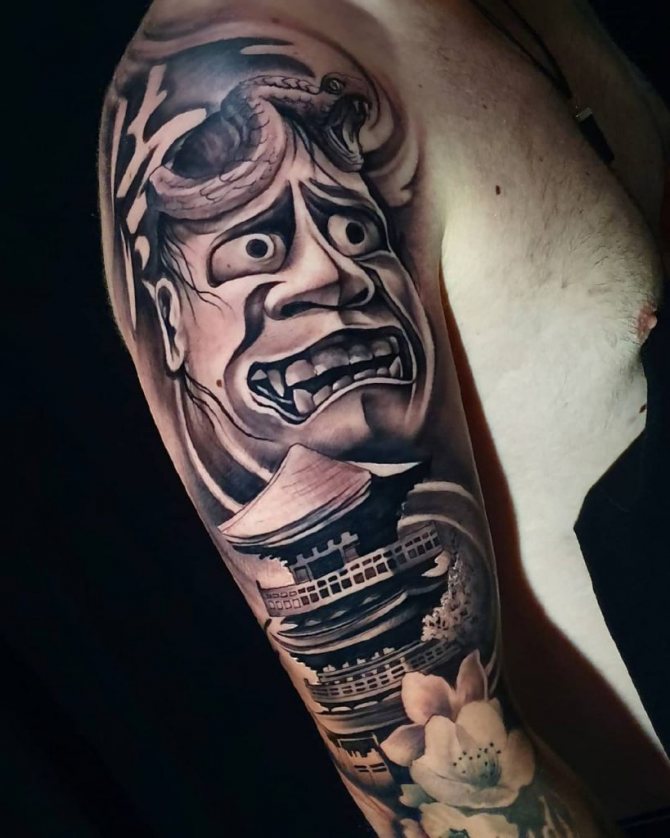
Japanese masks and their meanings
In Japanese mythology, demonic creatures took sinners to hell and locked them there forever. Drawings of negative beings are applied to the body to borrow their magical abilities, as in mythology, they easily regenerate lost limbs. They are also characterized by a sharp mind and great strength, so they are considered a powerful talisman for people.
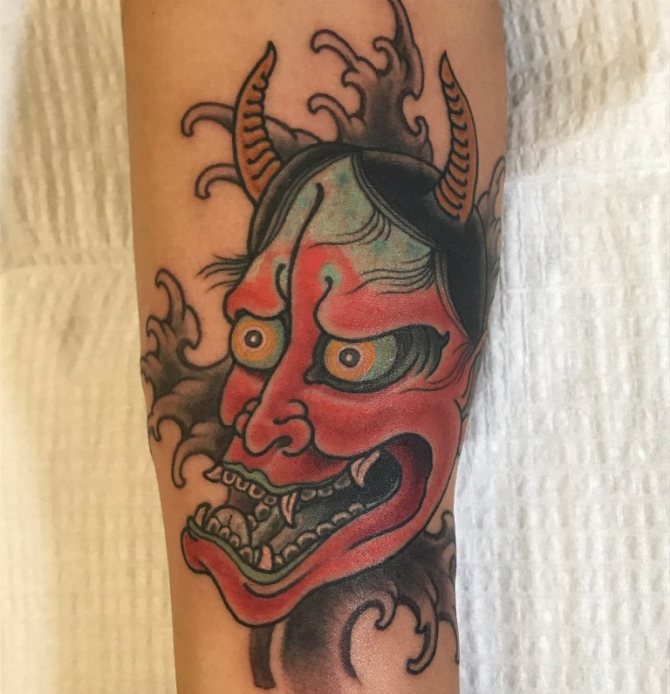

Japanese masks are characterized by bright colors.
The most common images of Japanese mask tattoos are considered those that are disassembled below.
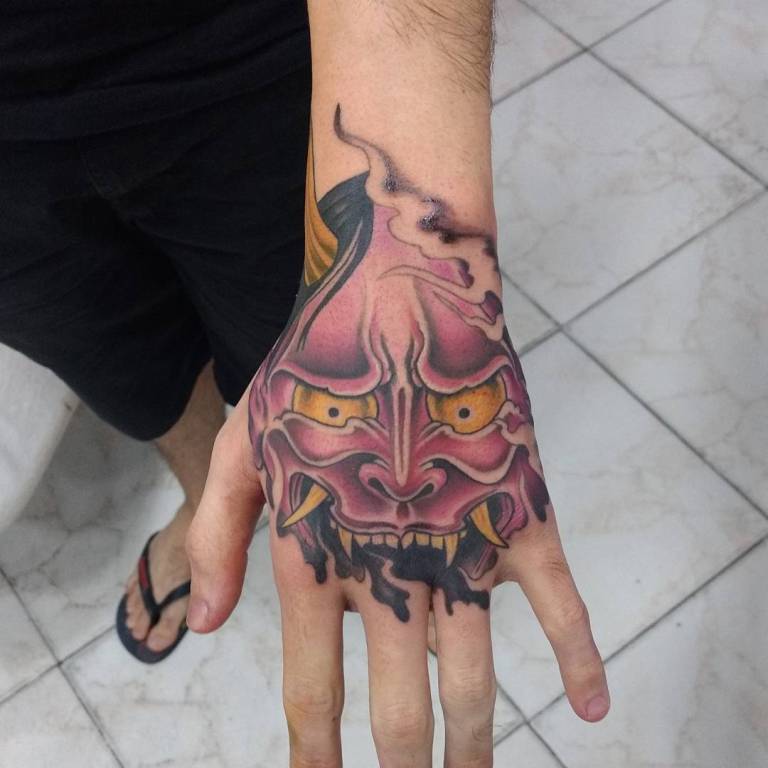

Demon Oni. This is an evil humanoid-like creature, possessing horns and fangs. It is almost impossible to kill him, as severed body parts grow back. Tattoo Oni performs a protective function, protecting good people and punishing undeserving ones.
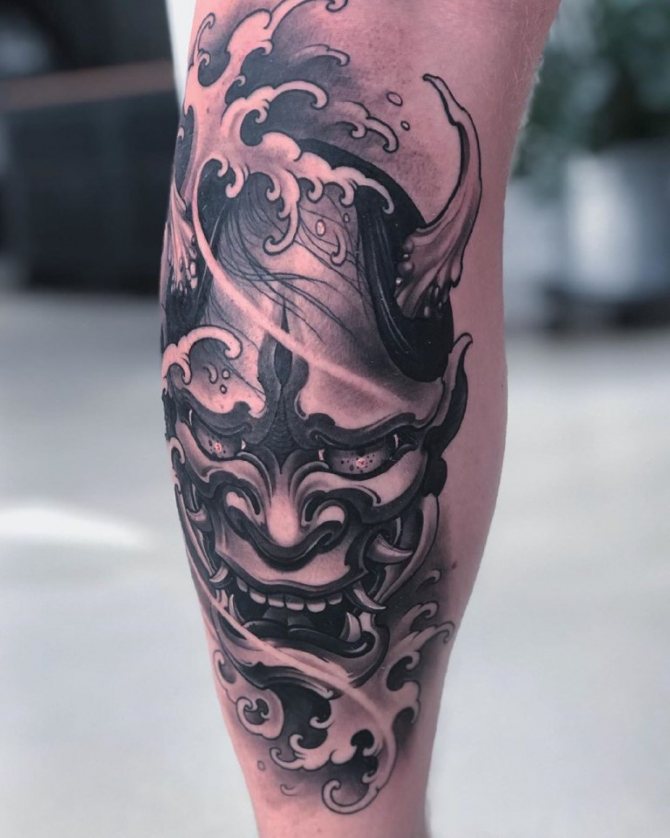

Demon Hania. Represents a creature with horns and fangs. Japanese mythology holds that he was transformed into a vengeful and jealous woman. However, on tattoos it is depicted not in a negative sense, but in translation it means "wisdom". Tattoo of the mask of Chania is a powerful amulet that separates its wearer from evil beings.
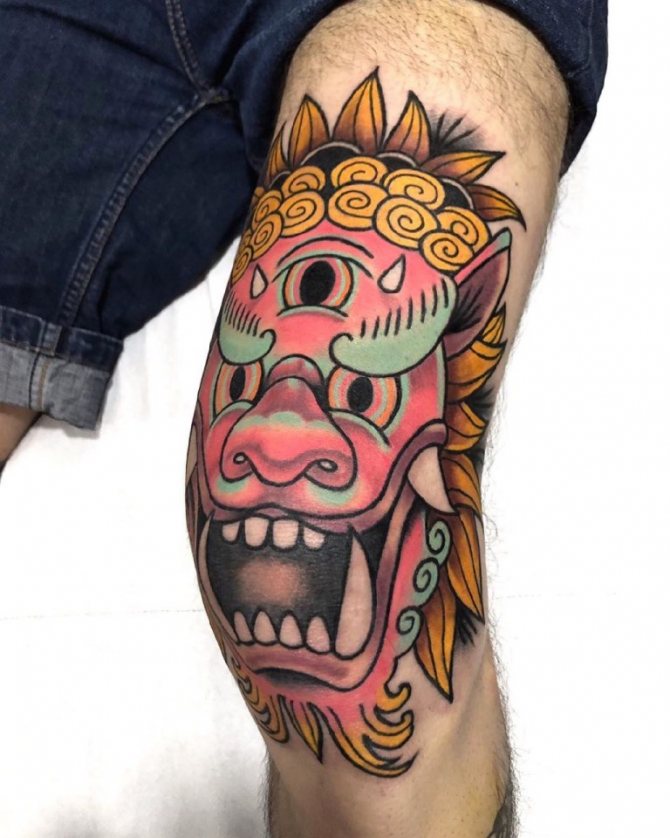

Hanja mask is a reliable protection against evil spirits.
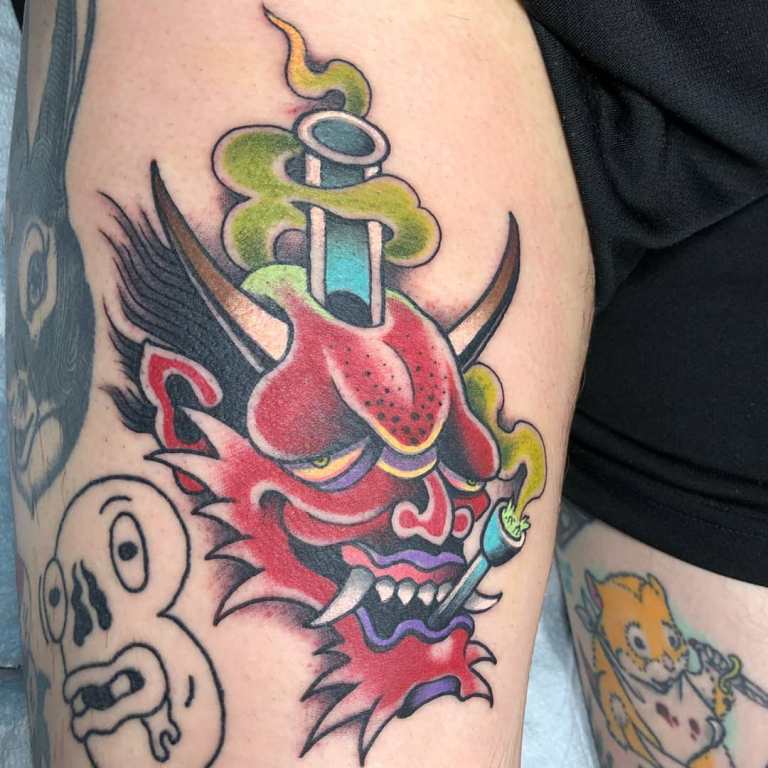

Tengu demon mask. There are 2 varieties of Tengu: Karasu-Tengu and Yamabushi-Tengu. The first is depicted as a raven and the second looks more like a man. Yamabushi-Tengu is a humanoid creature with a red face, a long nose, and is also sometimes depicted with wings. He can be compared to a leshim, but he helps good people more and punishes those who harm the forest.


Tattoo of the devil. A grim, sinister force, portrayed with a dose of humor and mischief. Sketches are applied in the form of a demon or devil. A popular subject for male tattoos. May be depicted with a pitchfork or hammer. This tattoo symbolizes envy, evil, guile, sinfulness and mental death.
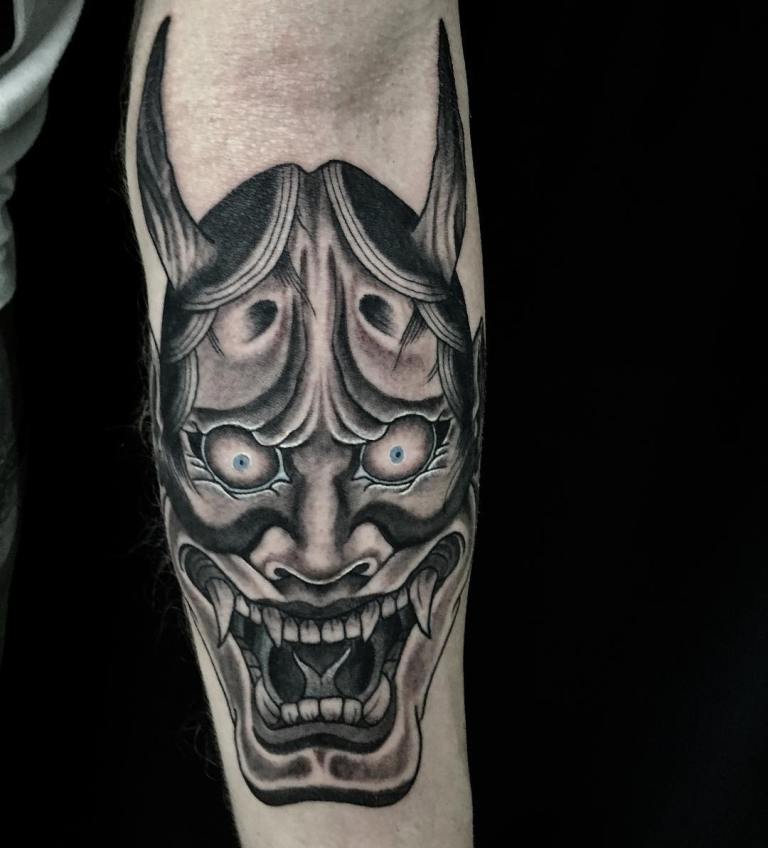

In addition to the tattoos presented, popular images include images of the thunder god Radzin, Ondeko-man, Yakshu, Rokurokubi, Kitsune, etc.
Japan: the history of masks
The mythology of the Japanese is very rich in characters with sometimes completely opposite character traits. The fact is that in Japan it has always been customary to get along with a mass of demons and unclean spirits. The wise inhabitants of the islands never fought with evil spirits, they, on the contrary, begged them and, if necessary, could always enlist the support of the spirits.
Masks have always had a sacred meaning to the Japanese, they were quite often used by the samurai in battle. It was believed that the mask not only covers the face, but also, accommodating various spirits, helps the warrior to win, instilling terror into the hearts of enemies.
It is hard to imagine Noh theater without various masks. The tradition of theatrical performances emerged around the seventh century. At this time colorful theatrical shows were held near temples, and masks were made of clay and paper. They were extremely simple and served to conceal the actor's persona. It wasn't until the seventeenth century that Noh theater became something special, and masks became a real art form. They began to express various characteristic emotions and served now to better characterize the characters of the performance. Masks were endowed with mystical powers, and touching them was allowed only in the place where the laces were attached. Now in every theater there is a kind of altar on which the ancient masks are collected. It is believed that the souls of the actors live in them.
Tattoo demon: meaning
The meaning of the demon tattoo does not refer to intimidating symbols. The demon tattoo is the embodiment of a large number of temptations and temptations, with which a person fights every day.
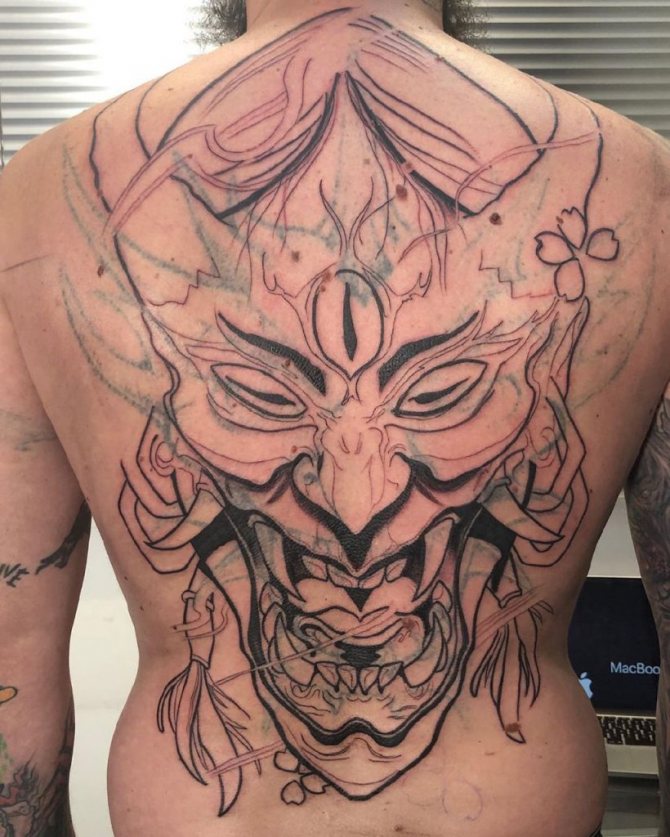

In many cultures, demonic tattoos are a sign that one is aware of the constant shenanigans of dark forces and is willing to fight them. Drawing a demon on the body is a symbol of power over evil, victory over the influence of the demon and the primordial beginning of one's own consciousness. Dark colors are used to better emphasize the sacredness of the tattoo.
Tattoo demon as a talisman choose strong and purposeful people. The negative power of the creature is not the key. The drawing encourages people to think more about avoiding weakness, dejection and not to despair after the first failures in the conceived business.
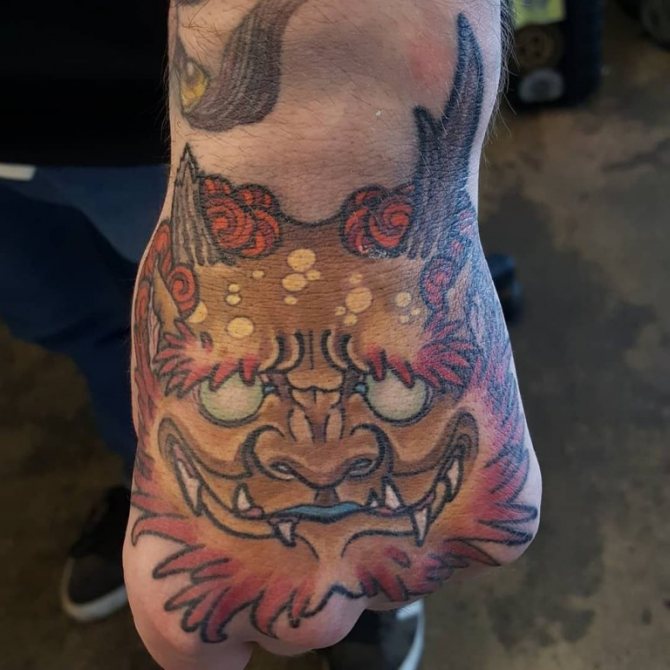

Dynamic poses in the tattoo highlight the rebellious nature of the owner, the confrontation with society and conventional values. Often such signs are used by Satanists and necromancers.
Exile Oni to Hell
Japanese demon masks They are especially often used on the holiday of exorcism of demons. It is held on the third of February and is widely celebrated in the country. In order to protect their homes, the Japanese scatter soybeans everywhere, which they simply can't stand. In recent years, it has also become common to scatter peanuts, sometimes wrapped in gold foil.
On the streets of cities on the holiday there is always a theatrical procession. Men dress up in costumes Oni and necessarily wear frightening masks. It is considered very correct to decorate the house of a demon mask: thanks to this amulet in the house will not penetrate the evil, and all the household can not be afraid of being in a dream in hell.
The best places on the body for a tattoo demon
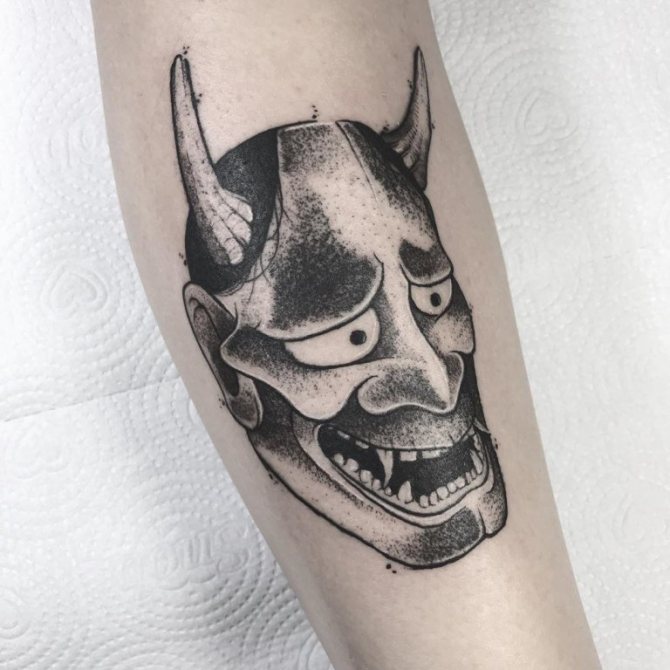

The most common tattoos depicting demons are drawn on:
- back;
- shoulder;
- forearm;
- arm;
- neck;
- chest and collarbone.
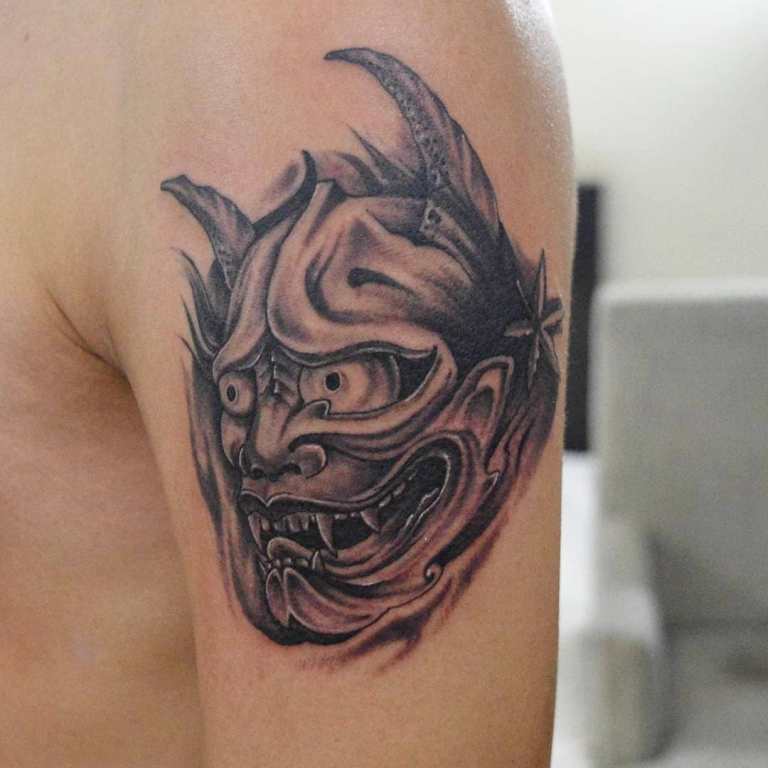

Effectively look demon tattoo in a large expression clearly drawn throughout the arm. Will look brightly demonic image on the chest or thigh. Full-length creatures look best on the back, but many guys prefer to do a tattoo on the shin.
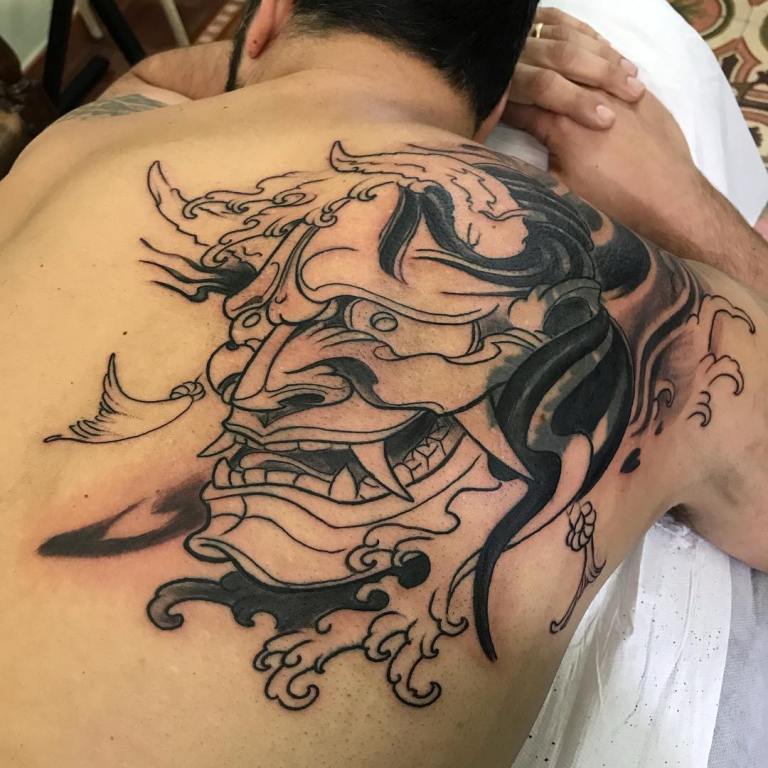

Japanese Tattoos - main subjects
Tattoo Japan Carp
- One of the most popular subjects. The symbol of the carp became popular thanks to the legend of Makatsuge, a fish that reached the Dragon Gate and turned into a dragonfish through his persistence. In the legend, this fish was a carp. Carps (or as they are called in their homeland - Koi) symbolize perseverance, the ability to swim against the current. Traditionally, a tattoo with a carp is considered masculine, and embodies male energy.
The Turtle tattoo
Oriental peoples tattoo symbolizes wisdom and the ability to predict the future.
Tattoo of the Dragon
- A symbol of sunshine, good luck and longevity. The Japanese depicted dragons with three fingers on their paws. Legend has it that the dragon is considered a sacred guardian spirit and is revered by humans.
Tattoo of the tiger
- A symbol of courage, strength, bravery, and nobility. The Japanese believe that tigers can ward off evil spirits.
Tattoo Snake
- protection from misfortune and bad luck, snakes have superpowers that help people avoid trouble. The image of a snake coiled at the hammer brings good luck, wealth and prosperity.
The Chania mask tattoo
- is an image of an ancient spirit turned into a jealous girl. This image according to one version symbolizes the embodiment of wisdom, and according to another reminds people of how destructive it is to give in to negative feelings.
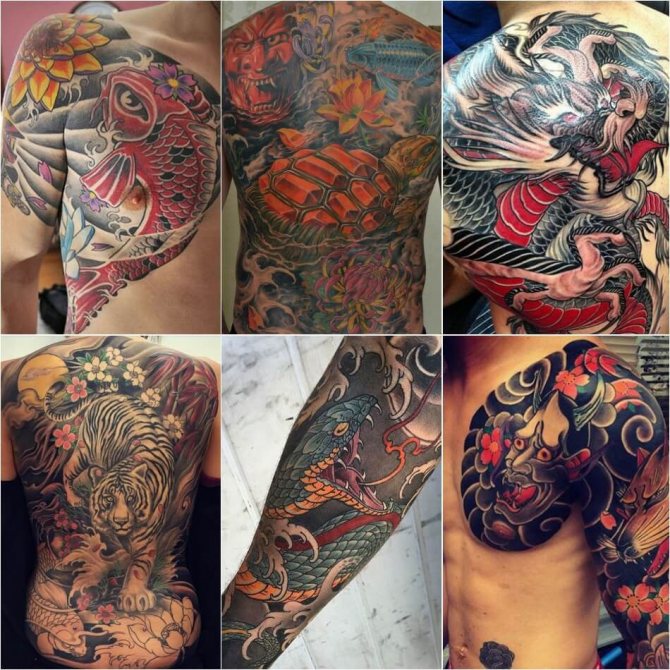

Demon tattoo designs
Women often choose to apply a tattoo image of the Succubus. This creature inclines people to engage in carnal pleasures with him. Often portrayed with a cute female appearance and an ideal figure. The bearer of such a tattoo acquires sexual freedom, causes a desire and lust.
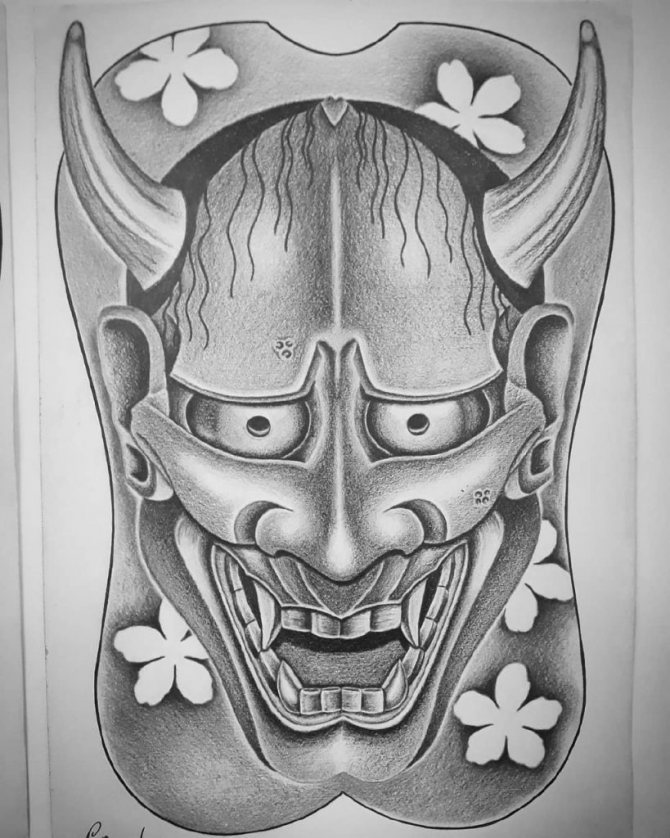

These motifs are the most popular all over the world.
Small tattoos, accessible to the eye, draw attention to their owner, who has mastered the inner demonic, but has not lost her wit and desire for entertainment.
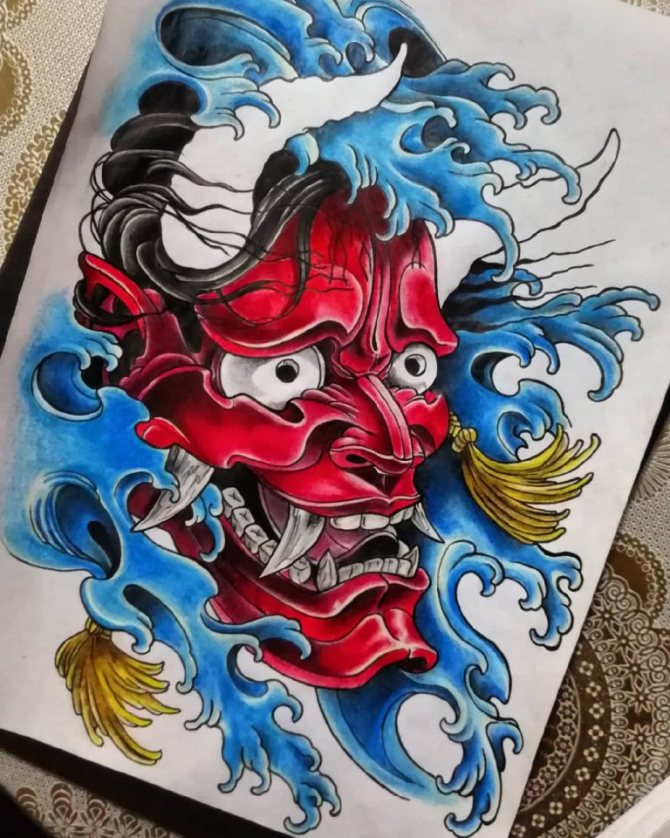

Grim and even sinister images on a woman's body communicate a cynical and shameless character. This is not always negative for the girl, as this rather indicates her straightforwardness rather than rudeness and vulgarity.
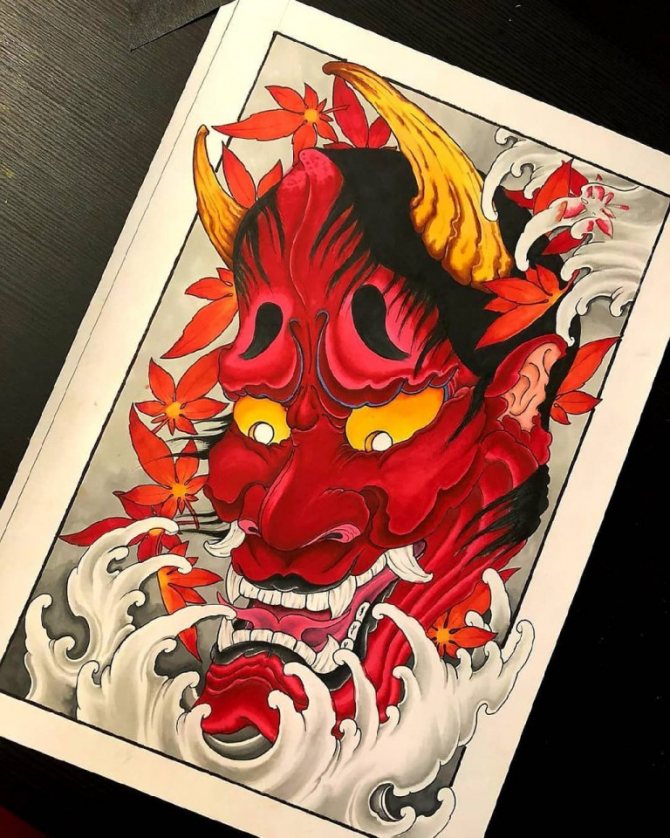

Men's tattoos of Japanese demons are pounded on by those guys who:
- Don't want to take life seriously;
- are easily tempted and addicted to gambling;
- rarely have a good time.
The image denotes a reproach to one's personality or serves as an excuse for weakness. The symbol represents both strengths and weaknesses in a man's character.
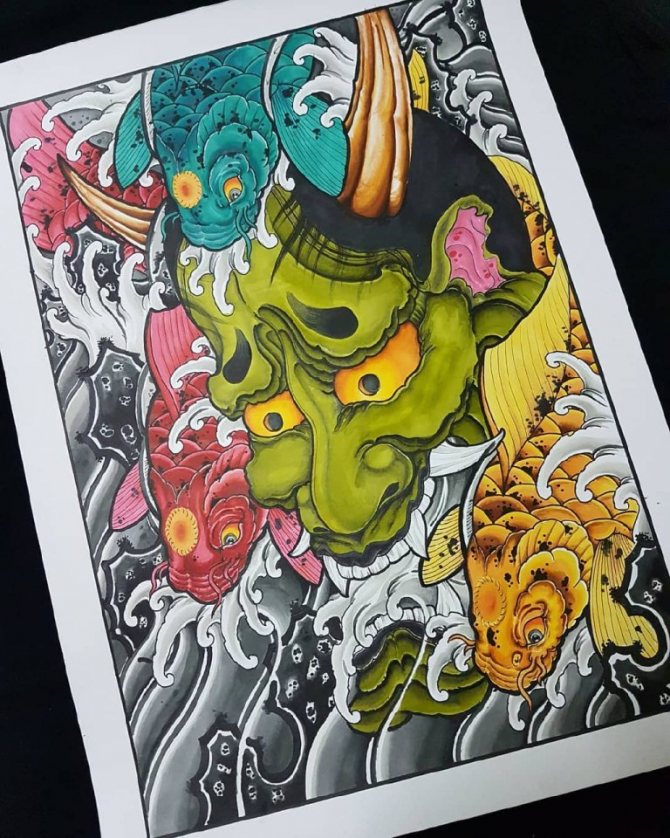

We hope that the presented tattoo sketches will help you make the best choice for the future drawing.
Choosing where to apply
The mask of Chania (the sketch of which is the embodiment of the suffering soul, which carried out its revenge, but at the same time did not find peace) is often enough stuffed on a large part of the body.
For the greatest effect of sacredness, in the manufacture of the tattoo is used black in combination with a bright and catchy design.
Quite often the Hania mask tattoo is made voluminous and is most often inscribed on the areas:
- back;
- abdomen;
- side;
- forearm;
- shoulder;
- leg;
- arm.
After the preparatory work on the choice of a drawing, you should pay attention to the ratio of the size of the tattoo and the selected area. It is necessary to match in proportions the stylistics, color scheme and place of application in order to achieve harmony in correlation of the image size and the chosen part of the body.
Each person chooses his own priority areas for tattooing. The chosen sketch must correspond to its wearer and have a similar character to it. The customer must feel comfortable with the chosen design, he must feel a certain connection with the object applied to his body.
Forearm
The forearm is the most popular part of the body for tattoos. The image in this place can turn out the most volumetric due to the shape of the hand.
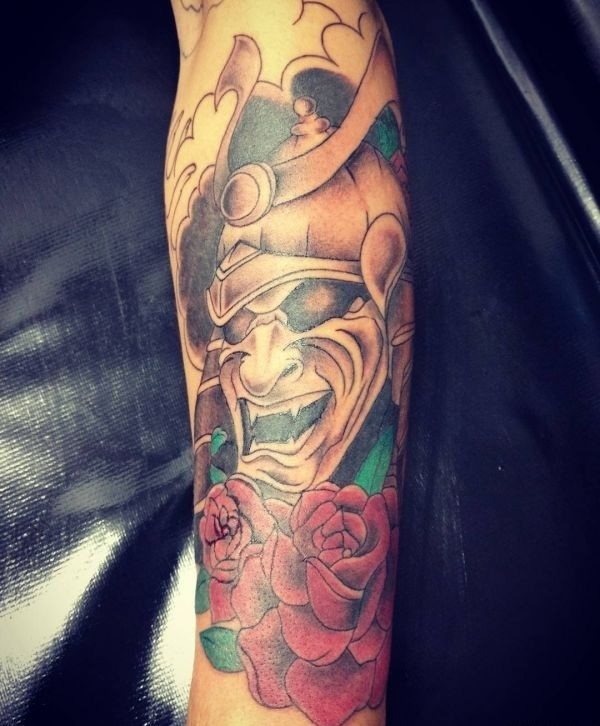

To do this, you just need to detail the drawing and perform smooth color transitions.
Arm
The tattoo called "arm" implies a drawing applied to the whole arm of a person. Sometimes it is performed in the form of a full or partial sleeve. In this case, the mask is supplemented with details in the style of watercolor or old skool. This gives the image an originality and causes genuine interest in others.
There are 4 types of application of such tattoos:
| A full-length sleeve. | The tattoo is applied to the whole surface, runs from the shoulder and ends at the wrist. Also, it can be extended to the toes or run down the inside of the palm. |
| Three-quarter sleeves. | In this application, the image starts at the shoulder and does not go all the way to the wrist. |
| Sleeve 1/2 | The tattoo is applied from the shoulder part of the arm and reaches to the elbow. Such a tattoo may well be concealed under clothing. |
| Sleeve on 1/4 | In this format, the tattoo is located on the shoulder or forearm in such a way that it is easily concealed under a short sleeve T-shirt. |
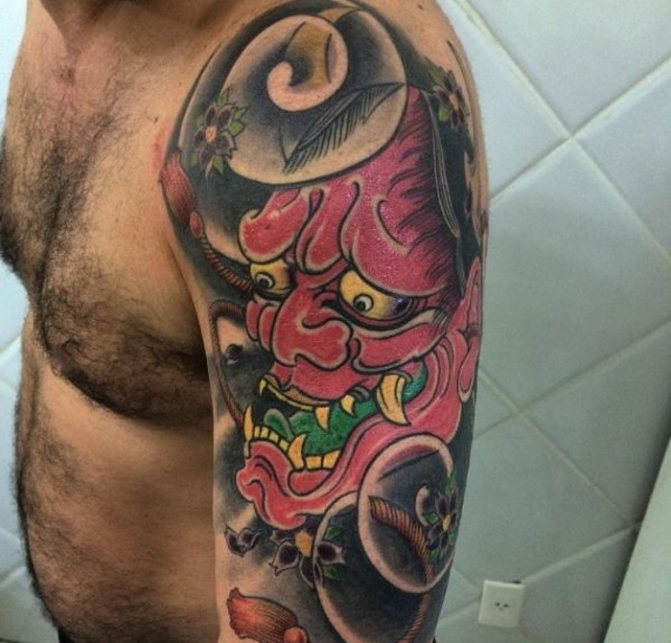

With this application, a whole story composition consisting of several parts is usually chosen.
Back
The most appropriate is considered the placement of the tattoo of the mask of Chania on the back. On the largest part of the body, you can make a large-scale composition with meaning. Large size tattoo is a multi-way complex work, so making a composition on the whole back can take about 1 year in time. The direction of the entire drawing is given by the understanding of the subject. Each composition has a key image that gives an understanding of the whole meaning of the tattoo. The rest, gradually added details, only help to achieve harmony in the perception of the whole picture.
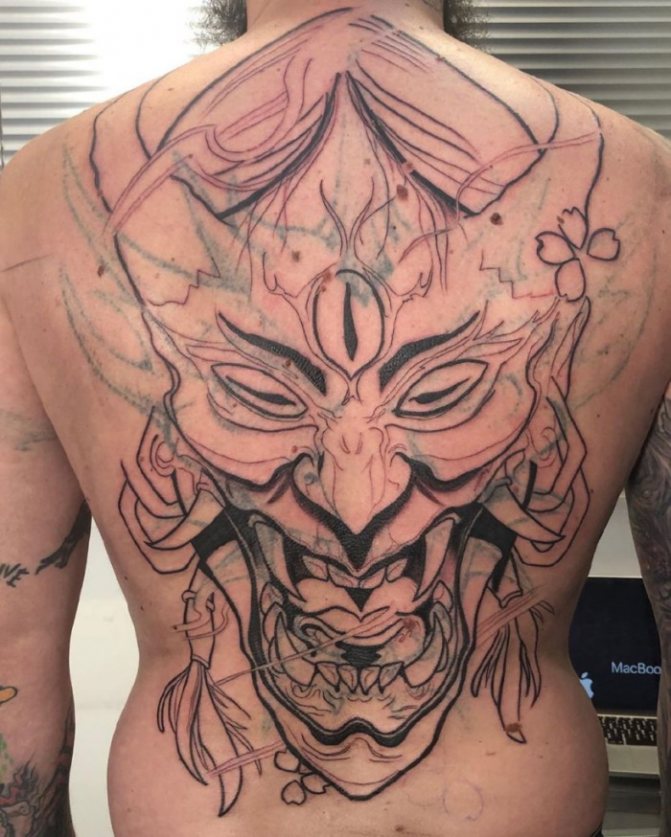

Due to the fact that the back is not subject to age changes, the tattoo will be kept in its original unchanged form for many years.
Foot
The image of the Hania mask on the leg is extremely rare.
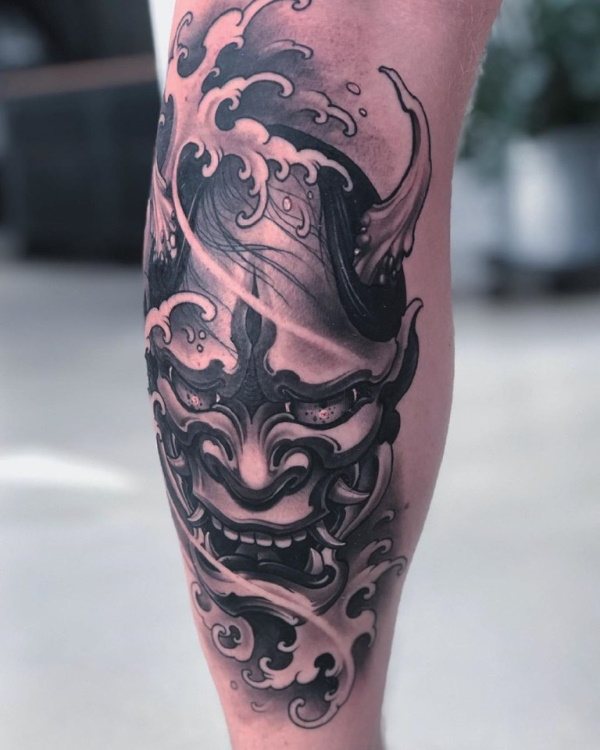

The limitation of the surface can be a barrier to the transfer of the semantic subtext and depth of the figure.
The loincloth
A tattoo applied to the lumbar region of a person will look very interesting.
Scapula
An excellent place for the tattoo can be a part of the scapula, in this case, the main thing is to choose the correct sketch, suitable for the chosen site.
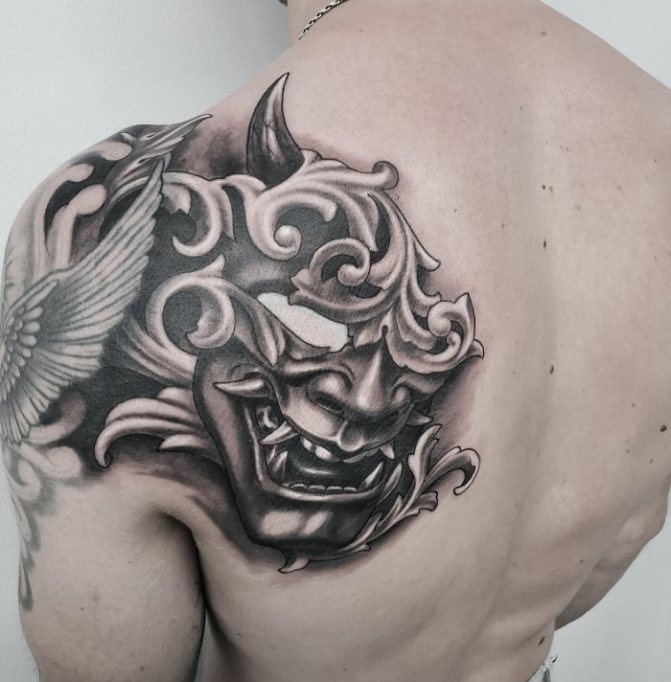

Chest
The image of the Hania mask on a girl's chest will look mysterious, but it should be taken into account that stretching the skin in this place can make the drawing look less attractive and deform it.
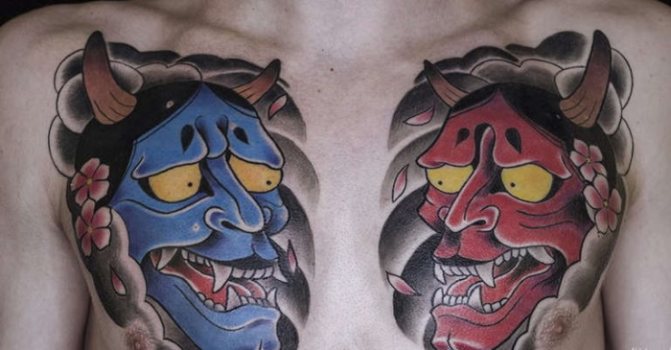

Thigh
Tattoos on the thighs are usually done by very young girls. Such a sketch can emphasize individuality, slimness and uniqueness of the thigh line.
Tattoos for women and men can be similar in subject matter, but applied to different parts of the body.
Men's designs
Men usually put a tattoo on the whole area of the arm receiving thus the so-called battered "sleeve", not affected zone at such beating becomes only a brush.
Less often for the application of the tattoo mask on the body are used areas:
- chest;
- back;
- ankle.

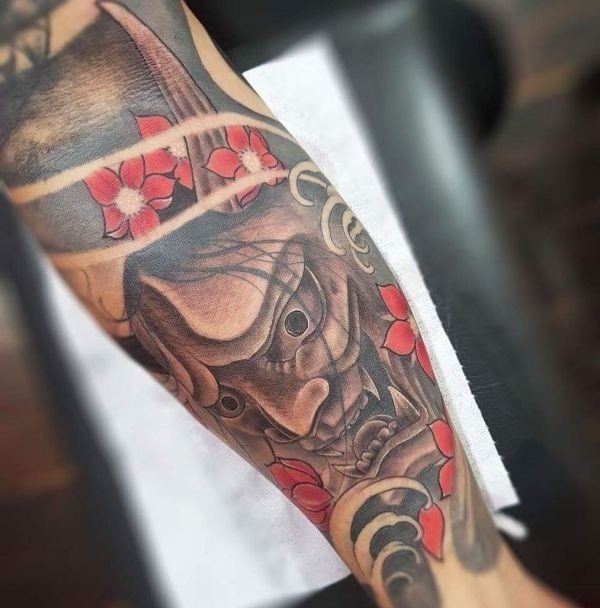
The place of application is chosen based on the meaning that the future bearer wants to show.
Women's sketches
The female half of humanity quite rarely uses the plot of the Hania mask to apply to their bodies, usually girls are attracted to more romantic subjects. When choosing the mask of Chania it can be stuffed on the thigh part, in this performance the image becomes inaccessible to prying eyes. Much less often, the mask hanya tattoo can be seen stuffed on the stomach, wrist, chest, foot, collarbone or neck.
Sketches of the mask of Chania tattoo
Below are the most popular sketches, which will help to facilitate the choice of the future drawing.
Use of masks
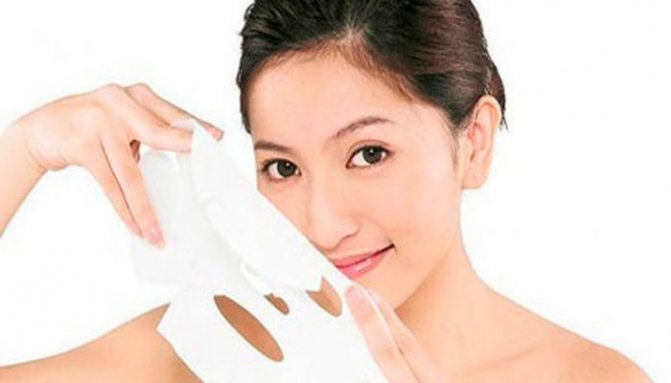

The basis of the mask is a cotton cloth impregnated with active substances, the composition of which is selected to solve a particular problem. To avoid infection, they often come with special tongs, which make it easy to remove the masks one by one. Due to the tightness of packaging they can be stored in the refrigerator.
The rules for applying the mask are as follows:
- Take it out of the bag and put it on the pre-cleaned face.
- Smooth out the cloth, ensuring maximum tightness to the skin.
- Leave on for 20-30 minutes.
- Remove the tissue base.
- Distribute the rest of the product on the skin with massaging movements.
Photos of tattoos with Japanese masks and demons
Presented photos of tattoos of Japanese demons and masks show the drawings in all their glory. You can see for yourself by viewing the selection.
The mystery of the image
The history of the mask is not an easy one. Once upon a time, a girl fell in love with a hermit monk, very passionately and without reciprocity. The monk continued his spiritual exercises and wanderings, and the girl became embittered, very angry in response to such disregard for her feelings.
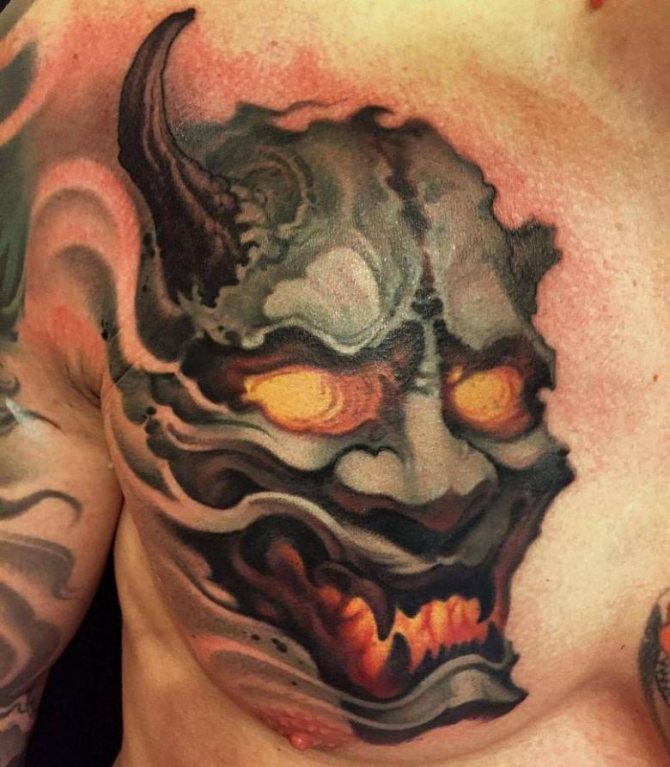

The bitter resentment turned her into a powerful demon of vengeance. She caught up with the monk and scorched him with the fire of her breath. But after that, she was overcome with pain and regret. Since then, she has become a lonely demon who punishes insensitive and indifferent men, sometimes you can hear her moans of lost love in the wind.


In Japanese culture, very often the characters have a double meaning. In this case, hanya serves as a reminder that it is one step from love to hate, anger can kill love, and rage brings disappointment. A long life is needed for forgiveness and understanding, compassion and the search for wisdom.
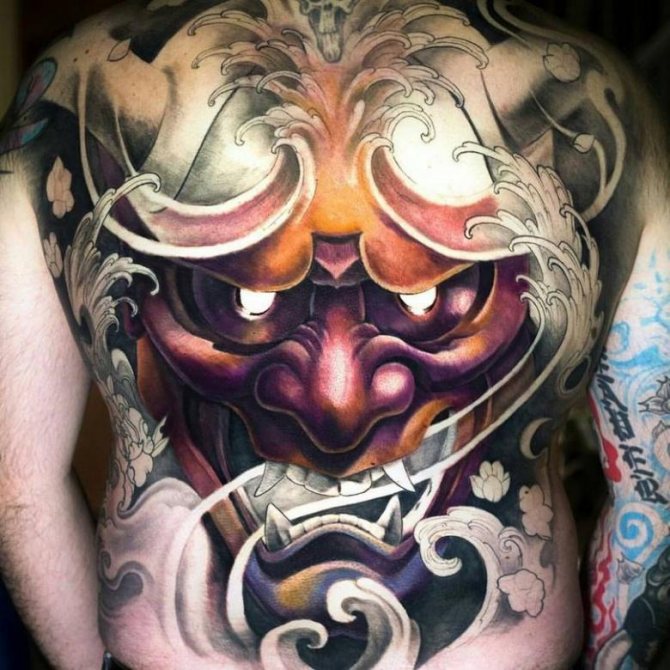

There is another version that could also be the reason for choosing a hanja tattoo. It is said that such masks were made by a master named hanya-bo for ritual dances. It is a horned face with a toothy grin, and appears to weep when viewed from the side. Oddly enough, it is a feminine image, though it is difficult to call the ugly face feminine.


Features of compositions


The main benefits of cosmetic products from Japan are due to the following components in their composition:
- Hyaluronic acid. It is present in almost all masks. It is designed to rejuvenate and moisturize the epidermis;
- Seaweed or its extract makes the dermis elastic, increases elasticity, improves complexion, slows down aging;
- Collagen. It is produced by the body itself, but when supplied from the outside, it promotes elasticity and tones the skin;
- Fruit and plant extracts. Means with them are suitable for women wishing to get rid of wrinkles, inflammation, pigmentation, freckles or problematic rashes;
- Vitamins. The most common are vitamins from groups A, B, C and E. Considered to be the best components in combating signs of fatigue, swelling and aging;
- Rice Bran Extract. Excellent against hyperpigmentation, evens out the complexion;
- Rice oil is a reliable protector against ultraviolet rays and drying out of the skin.
The key feature of such masks is that they can be used for any skin type and any age
The main thing is to pay attention to the purpose of the specific product. For example, products with hyaluronic acid or collagen are suitable for women 35-40 years, and with seaweed - for girls under that age.
Preparations with fruit extracts perfectly cope with pigmentation and freckles, so they can be used by anyone who wants to eliminate such defects.
Also, the Japanese have developed masks for cooking at home. They include traditional products for this country: rice, green tea, seaweed.
